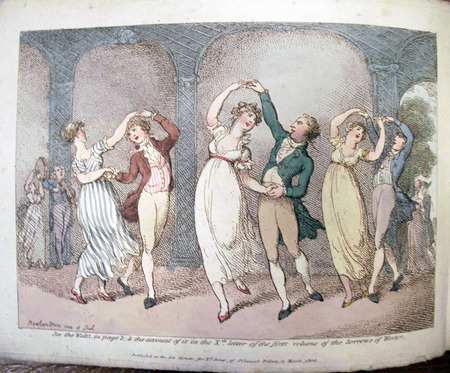Edward Jones (1752-1824), A Selection of the most Admired and Original German Waltzes, never before Published; adapted for The Harp, or Piano-Forte; Most respectfully Dedicated, by Permission, to Her Royal Highness Princess Charlotte of Wales, by Edward Jones, Harp Master, and Bard to His Royal Highness the Prince of Wales (London: Printed for the Editor, 1806). Frontispiece drawn and engraved by Thomas Rowlandson. Graphic Arts Collection, Kane Room Rowlandson 1806.4
Welsh harpist Edward Jones dedicated this group of waltzes to ten-year-old Princess Charlotte of Wales, the daughter of his patron George, Prince of Wales later to become King George IV. At the time, Jones was living in St James’s Palace. A collector of music, Jones was clearly ahead of his contemporaries in his appreciation for the waltz. While popular in Austria and Germany, the dance had not yet penetrated British Society.
According to Erin Smith, writing for the Jane Austen Society, “dance historians can point to the exact moment the waltz was introduced officially into mainstream English society: the King’s Birthday Ball in July of 1816, almost to the day that Austen put her finishing touches on the first draft of Persuasion and just under a month before she finished it completely. In a review dated 16 July 1816, a writer from the London Times reported: ‘We remarked with pain that the indecent foreign dance called the Waltz was introduced (we believe for the first time) at the English court on Friday last.’” Erin Smith, “Dancing in a New Direction: Jane Austen and the Regency Waltz,” Persuasions On-line, v. 30, no. 2 (spring 2010)
Jane Austen (1775-1817), Northanger Abbey: and Persuasion (London: John Murray, Albemarle-street. 1818). Rare Books (Ex) 3612.1.368.11


